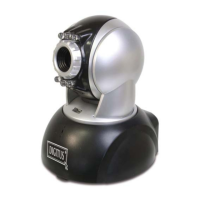`
DN-16032 User’s Guide
P
P
a
a
n
n
/
/
T
T
i
i
l
l
t
t
I
I
P
P
S
S
u
u
r
r
v
v
e
e
i
i
l
l
l
l
a
a
n
n
c
c
e
e
C
C
a
a
m
m
e
e
r
r
a
a
DN-16032 USER’S GUIDE PAGE 43/61 Rev. PV1.0
Mode and Passive Mode. You must be able to write to the root folder of the ftp site to use
this feature.
How to use FTP Server settings:
Step 1: Enter the IP or HTTP address of the FTP server in “IP/Host”
Step 2: Enter the designated FTP port number in “Port”
Step 3: Enter the account ID of the FTP server in “Account ID”
Step 4: Enter the FTP server password in “Password”
Step 5. Select whether you wish to use “Port Mode” or “Passive Mode” transfer
protocol.
Step 6. Click on Submit when you are finished.
5.5.3 DDNS Server
This menu allows you to enter your DDNS (Dynamic Domain Name Server) Settings. You
can also use a PPPoE (with dynamic IP) to connect to the http address of the IPCAM
(such as sqipcam.dyndns.org) by entering the registered HTTP address of the DDNS
Server. This is convenient for viewing IPCAMS with non-fixed IP addresses.
Entering the DDNS Server Settings:
Step 1: Find a DDNS service (such as http://www.dyndns.org
), and register a user
account, password, and HTTP user address.
Step 2: Enter the address (IP or HTTP) of the DDNS server. Enter the host name,
account ID, and password in each appropriate field.
Step 3: Enter the account ID of the DDNS server in “Account ID”
Step 4: Enter the DDNS server password in “Password”
Step 5. Select the DDNS server connection status automatic display setting.
Step 6. Click on Submit when you are finished.
5.5.4 NTP Server
NTP(Network Time Protocol) allows you to calibrate the IP CAM timing.
Using the NTP Server settings:
Step 1: Enter the NTP Server IP or HTTP address in “IP/Host”
Step 2: Select the correct time zone in the “Time Zone” menu
Step 3: Click on Submit when finished.

